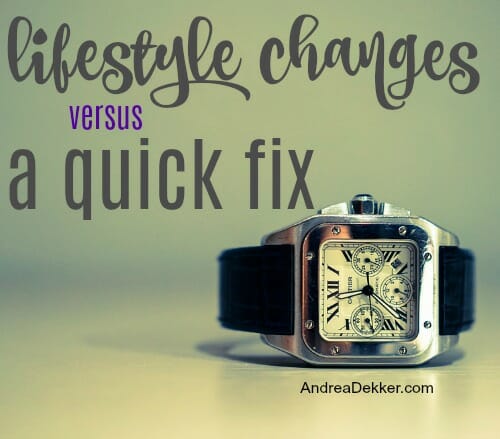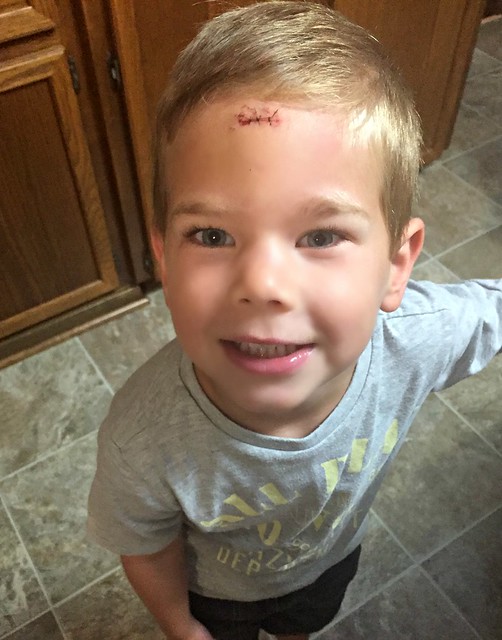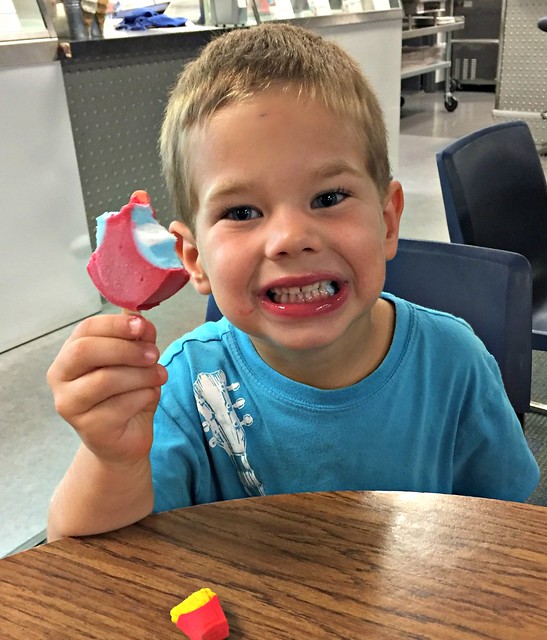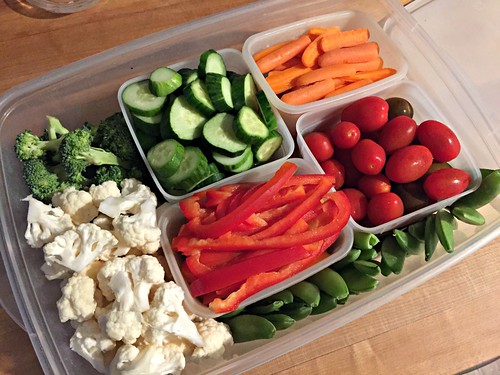
Exactly one month ago, we had to unexpectedly rush Simon to the Emergency Room for stitches in his forehead — not at all what we wanted to do at 10:30pm on our weekend vacation with Dave’s family!
However, Dave’s sister (a nurse) assured us that simply using a butterfly bandage as a “quick fix” really wouldn’t be sufficient, and would probably leave a pretty nasty scar later on (not to mention risk an infection).
In order to make sure the wound was properly cleaned and carefully “mended”, we had to inconvenience ourselves, spend considerably more time and effort than we wanted to, and fork out a bunch of money… but it was worth it for us to know the situation would be handled professionally, with the best care, and with the best long-term results.


Now, one month later, there is almost no indication of where that gaping hole was, and Simon enjoys bragging about “that time he smashed his head open and went to the ER!”
I’m so thankful we didn’t opt for the “quick fix” in exchange for a little more short-term convenience!
Similarly, when we tackle various house and yard projects, Dave and I have had SO many instances where we could save a considerable amount of time (and money) by taking a shortcut, cutting a few corners, opting for cheaper materials, or rushing through the process to finish faster (I know some of you DIYers can relate!)
Most of the time, we catch ourselves before falling for a money-saving, low-quality short-cut. However, the few times we have gone ahead with a cheaper, faster option, we have regretted it later on.
We’re getting smarter (at least when it comes to home renos!) and we’re much more willing to take our time, spend a little extra money, and patiently wait until we can get it exactly the way we want it.
Yes, our bathroom renovation is taking FOREVER (seriously, I don’t even want to talk about it) but that’s because we’re waiting on our most favorite tile guy who is currently booked. I really want tile floors and I really don’t want to do them myself… so we’re waiting… and waiting!
At least I decided on a fun color for the cabinets (and it’s not even white!)
In general, I feel it’s safe to say that most ‘quick fixes’ really don’t stick for the long-term — and yes, I do think this theory can be applied to so many aspects of life.
For example:
- finances and budgeting (taking out a loan to pay a different debt but not changing your spending habits)
- dieting and exercising (binge dieting to lose 10 pounds but then reverting back to your normal eating habits)
- cleaning and organization (shoving things in drawers or closets so the spaces look clean, but never purging or organizing things within the storage spaces)
- physical, mental, and emotional health (ignoring health issues or assuming they will fix themselves over time)
- relationships with others (buying a gift or splurging on a special treat as a bribe or to “apologize” instead of actually getting to the root of the issue and trying to change for the better)
.
Of course, there will ALWAYS be exceptions to this rule and situations when quick fixes or cutting a few corners really won’t harm anything. However, if you feel like you’re currently not meeting your goals, or maybe even moving backwards, it might be because a lifestyle change is needed instead of just a quick fix.
For example:
- finances and budgeting (changing your lifestyle in order to save more, spend less, and work your way out of debt)
- dieting and exercising (changing your lifestyle to include healthier food options, less eating out, more movement and exercise, and more nutritious food choices)
- cleaning and organization (changing your lifestyle to stop buying so much, purging more regularly, and creating homes for everything you have so it’s not sitting out all the time. )
- physical, mental and emotional health (changing your lifestyle to include healthier habits, visiting the doctor, and looking into different ways to improve your physical, mental, and emotional health for the long-haul)
- relationships with others (changing your lifestyle to address uncomfortable issues instead of just ignoring them or trying to cover them up.)
.
As many of you probably already know, lifestyle changes are SO MUCH MORE WORK and usually take significantly longer to implement and enjoy the benefits. However, if you’re looking for long-term results that are actually maintainable, lifestyle changes are definitley the way to go!
I wouldn’t recommend trying to make too many lifestyle changes all at once though.
Choose one area to focus on, decide what types of changes will be necessary to achieve the results you’d like, and then SLOWLY start implementing a few of those changes.
.
Dave and I have been SLOWLY working to renovate our home and yard for 8 years now… and we’re almost finished (at least for now)! We just took one project at a time and kept plugging away.
Similarly, we began implementing a few small healthier habits into our lifestyle 6-7 years ago, and little by little, we have completely transformed the way we cook and what we eat.
It’s still amazing to me how much different my grocery cart looks now than it did 6-8 years ago. I could have never made all of these changes at once, but slowly, over time, we have made several lifestyle changes when it comes to what we eat — and they’ve stuck!
I realize your lifestyle changes might look much different than mine — but if you find that you aren’t making progress towards your goals, or you feel like you’re taking 2 steps forward and 1 or 2 steps backward again, it might be because the changes you’re trying to make aren’t sustainable for the long-term.
What are some lifestyle changes you’ve made (or are making right now)?






Ramona says
This has been the year of intentional change for me. Little changes each month in each goal are of my life ( health, finance, home, work and even self care). I concur that little changes make a big overall effect! Last year my cholesterol was through the roof and I used 2017 to work on changes in my diet, I slowly got rid of processed foods, fat free, reduced fat, etc and this year in January my cholesterol numbers were the best they have been in 5 years!!! Slow and steady always wins the race!
Andrea says
that’s awesome — and in only ONE year! God for you!
Carrie Anne says
Lisa Woodruff recommended your blog to parents with young children in her Organize 365 Home Organization challenge. And I’m so glad she did!
A big one for me is sleep hygiene. I work full-time as a professor and I frequently find myself staying up late to finish grading or write a few more emails. Then I try to use naps, weekends, or (most often) coffee as the band-aid for bad sleep habits.
So I’m trying to go to bed and get up at the same time every day. And cut off all electronic device use an hour before bed. But it’s hard, especially when your kids don’t fall asleep until 9 and you treasure that evening “alone time.” 🙂
Andrea says
yay!! Thanks for stopping by. Lisa is a fantastic referral partner for me — I’m so happy she loves my blog so much 🙂
And yes, staying up too late and/or waking up too early are some of my pitfalls too. There’s just always more I could do!
Karen says
I loved this post so much!!! You are so right about everything….I’m guilty of just shoving things in closets and drawers too. I have been purging like mad lately and am enjoying empty spaces. I vowed to myself to not let my guest room become a catch all. Empty closets and drawers ALWAYS is my goal. Ha ha my aunt just visited and definitely noticed I also don’t shop at Marshall’s and TJ Maxx unless I’m actually looking for something ~ that has helped tremendously. Also….we’ve been waiting (since May) for an open spot with our beloved landscaper to finish our blank backyard. It’s been tough all summer without grass, but we’ve watched the sub par jobs in the yards around us and we decided it would be worth th wait. Ha ha sorry for the book I just wrote.
Andrea says
empty space is SO refreshing… it’s always my goal to make more empty space (in my home and life!) Good for you!
Anna says
I like this topic. It’s been a struggle learning the differences in life-style changes versus quick fixes. Sometimes it takes me some time to realize I am doing a quick fix. Here are some of my life changes.
1. Eating vegetables and chicken. LOL I over the years had to keep trying them and cooking them in different ways before I figured out how to like them.
2. Not eating out so much. With 40+ hours this was and still is a tough one. It’s easy to eat out, spending less time grocery shopping and time cooking. But it really did do a number on my health now that I’m older. Plus it costs a lot to feed 5 versus 2 eating out.
3. Meal prepping – still working on this one. But it does save time and it makes sure I eat healthier meals.
4. Not doing all the cleaning – It is more simple and quicker to clean up and do everything that make sure my kids clean up their mess, help with the laundry and clean their rooms. It’s an easy quick fix now however in time it will be easier for them and me to know they can take care of themselves and help with the family.
5. Following routines – still a work in progress. We definitely started out doing things as needed. Cooking, laundry, fixing the house, working. Now I try to follow more routines as it helps me get everything done and be more prepared. Having less stress throughout the week.
6. Replacing household items – LOL This is always a hard one as I don’t usually want to buy something needed versus fun. It just seemed like these always seemed to be needed to replace all at the same time. Now I try to either replace one appliance per year or save enough money to buy a new appliance. This works out great the last few years…washer one year, fridge this year. They dryer is starting to go out so hoping to replace that soon as well. But we use to wait till they broke and buying on credit seems to be paying out longer than the appliance lasts.
Andrea says
Great list Anna! thanks for sharing such detail about what works for you. I’m certain it will be helpful for other readers!
Jess says
Yes to all of this! One way that my husband and I have been working to transform our eating habits (which have gotten WAY better slowly over the last several years) is that we no longer eat after 7:00pm. That was our worst time for snacking and binge eating sweets. We don’t worry about cutting everything “bad” during the day…yet. We tried to do a Whole 30 a year ago and it was too much at once and not something that either of us could sustain, and I know it’s not meant to be a sustainable eating plan anyway. But this habit change of not eating in the evenings is something we could do almost all of the time forever.
and sidenote: if we really are legitimately hungry in the evenings, for whatever reason, we listen to our bodies and eat a small nutritious snack, just not chips, ice cream, and more chips. 🙂
Anna says
That’s a great one Jess! I’ll have to try that one as well. I find myself snacking a lot in the late evenings.
Andrea says
slow and steady — I love it! And no, the Whole 30 thing is not supposed to be sustainable long-term (which sort of makes me question why anyone does it in the first place). It just seems like torture to me to make such a drastic change for 30 days and then go right back to normal again.
To each their own, I suppose 🙂
Also, I LOVE your “no eating after 7pm” rule. That’s probably my worst time in terms of unhealthy food choices too. I always want a little “reward” for a long day after the kids are sleeping — even if I’m not hungry! And I always lean towards unhealthy options too. I’ve been doing lots of yogurt parfaits with plain Greek yogurt and fresh fruit and granola. That’s at least better than ice cream or pie 🙂
Janet says
Just a note: Whole30 is not meant to be followed for 30 days and then go right back to your old way of eating. The point is to do a 30 day cleanse and then slowly reintroduce foods a little at a time, paying attention to how your body responds. From there, you learn what things affect you negatively, making you want to avoid them always. I learned that dairy mostly gives me a stomach ache, that the healthy fats I learned to use during my whole 30 helped with my joint pain, and that bread/carbs caused bloating.
Whole 30 made a huge difference in changing my lifestyle eating. A perfect lifestyle vs. bandaid “diet” for me. (Whole 30 is also not meant to lose weight, but it ends up being a happy by-product for most people.)
Andrea says
Yes, I do realize that… but the majority of the people I know do the Whole 30 as a “fad diet” to lose weight, not to figure out health or dietary issues. They do it for 30 days and then go right back to their old ways — which, in my opinion, is such a waste.